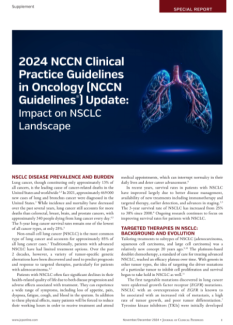The Crucial Role of the States in Advancing Cancer Care Policy in the US
As we enter 2025, the dynamic landscape of health care legislation continues to evolve, with significant implications for independent community oncology practices and patients across the US. In 2024, states took the lead in crafting policies to address the growing need for high-quality cancer care that is affordable and close to home. Several states were successful in curbing practices like white bagging, while similar measures in other states were defeated due to strong lobbying efforts from pharmacy benefit managers (PBMs). Whether it was a success or a failure, advocates can learn from the battles of 2024 to prepare themselves for 2025’s legislative sessions.
State-Level Advocacy: A Powerful Catalyst for Change
While federal efforts to reform PBMs or the 340B Drug Pricing Program hit roadblocks in 2024, growing action by state policymakers has been instrumental in bringing attention to these issues in Washington, DC. More bills were introduced to regulate PBMs than ever before, with strong bipartisan support for several bills. One such bill introduced in 2024 was the Lower Costs, More Transparency Act (HR 5378), which requires health care providers, insurers, and PBMs to disclose cost details, as well as report spending, rebates, and fees semiannually to health plan sponsors.1 These federal efforts stem directly from work at the state level, as policymakers in Washington seek to implement successful state policy on a national scale. Over the past two years alone, the Community Oncology Alliance (COA) tracked 72 bills with similar transparency goals across all states. This interconnection makes it vital for health care professionals and stakeholders to engage with their state legislatures actively.
Legislative Successes and Challenges
Several states have made headway in addressing complex issues such as white bagging and PBM practices. A notable success story came from Alaska, where HB 226 was signed into law, requiring PBMs to register with the state to conduct business. The law also imposes penalties for denying care or penalizing physicians for using a pharmacy not owned by the PBM. Similarly, significant legislation in Oklahoma and Oregon targeted white bagging practices, advocating for patient choice and emphasizing the need for stringent regulations. However, the path to legislative success is often fraught with challenges. While there has been progress on several fronts, PBMs and other stakeholders continue to lobby against reforms. Their primary argument centers around increased costs, seeking to sway lawmakers and delay comprehensive regulatory measures.2 A growing body of evidence and interaction with PBMs, however, is demonstrating to lawmakers that the “increased costs” argument is a smokescreen.
Looking Ahead: Priorities for 2025
As we approach 2025, several key issues remain at the forefront of legislative agendas. Chief among them is the ongoing debate surrounding the 340B Drug Pricing Program. While it is intended to benefit underinsured populations, recent state-led investigations have shown the program has been misused by large hospital systems and PBMs, who have used the funding stream as a tool to increase revenue rather than pass benefits directly to patients. Constituencies in several states have pushed back against lawmaker attempts to expand the scope of the 340B program, arguing that a lack of transparency is contributing to the diversion of money away from patients in need. The coming year will likely see increased discussions on the role of the program, how it is currently structured, and ways to ensure patients are benefiting as originally intended. Additionally, California and other states are expected to continue discussions on PBM reform, focusing on transparency and accountability. These developments underscore the need for continued vigilance and advocacy at the state level, ensuring that health care policies evolve in a manner that genuinely benefits patients and practitioners.
Engaging in Advocacy: How You Can Make a Difference
Participating in state-level advocacy is not just beneficial—it is essential. Your voice provides a first-hand perspective of the effects of various policies and shows lawmakers why change is needed. Whether you are a physician, administrator, pharmacist, nurse, or other member of the practice team, staying abreast of the latest legislative developments in your state could mean a world of difference for your patients. Stay informed by utilizing resources like COA’s policy tracker3 to monitor legislative developments in your state. Engage with local lawmakers by inviting them to “Sit in My Chair”4 and educate them about the reality of the patient journey. New to the world of advocacy? Join COA’s legislative leadership training program, attend state policy retreats, and connect with experienced advocates to learn the most effective methods of creating change.
The Road Ahead
While the legislative landscape is complex and ever-changing, the collective efforts of engaged stakeholders can drive meaningful improvements in cancer care policy. By understanding the interplay between state and federal initiatives and actively participating in advocacy efforts, we can ensure that health care reforms are patient-centered and impactful. If we can maintain the momentum of 2024 in the new year, we can ensure that 2025 is a year of groundbreaking change for independent community oncology practices and patients.
Clinical Pathway Category: Business
Financial and policy aspects of cancer care, including legislative efforts to regulate pharmacy benefit managers (PBMs), promote cost transparency, and address practices like white bagging that impact the cost and delivery of treatment directly influence clinical pathways.
References
- Lower Costs, More Transparency Act, HR 5378, 118th Congress (2024). Accessed January 9, 2025. https://www.congress.gov/bill/118th-congress/house-bill/5378
- Joyce G. Responding to some ‘inconvenient’ truths about PBMs. University of Southern California Schaeffer Center. August 12, 2024. Accessed December 20, 2024. https://healthpolicy.usc.edu/article/responding-to-some-inconvenient-truthsabout-pbms/
- Oncology pharmacy laws, regulations, and pending legislation. Community Oncology Alliance. Community Oncology Pharmacy Association. 2025. Accessed December 20, 2024. https://laws.mycoa.io/map
- COA’s sit in my chair program. Community Oncology Alliance. COA Patients Advocacy Network. June 10, 2024. Accessed December 20, 2024. https://coaadvocacy.org/education-resources/#sit-in-my-chair

















